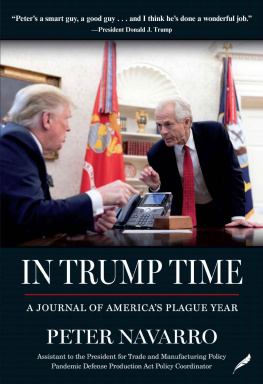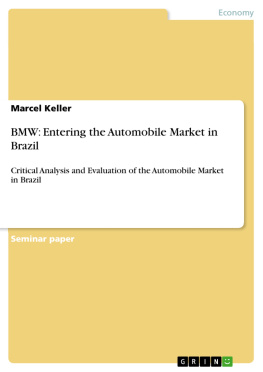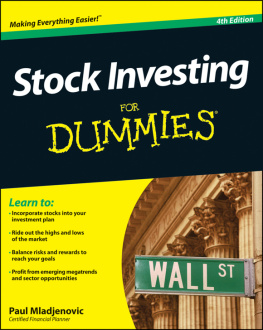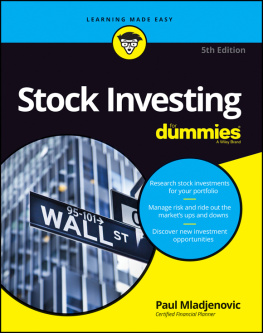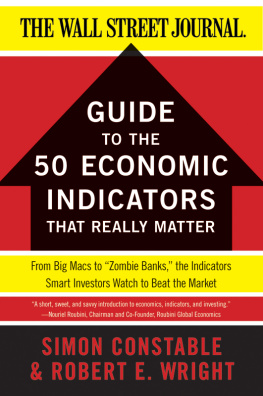

Copyright 2002 by The McGraw-Hill Companies, Inc. All rights reserved. Except as permitted under the United States Copyright Act of 1976, no part of this publication may be reproduced or distributed in any form or by any means, or stored in a database or retrieval system, without the prior written permission of the publisher.
ISBN: 978-0-07-141611-5
MHID: 0-07-141611-0
The material in this eBook also appears in the print version of this title: ISBN: 978-0-07-137369-2, MHID: 0-07-137369-1.
All trademarks are trademarks of their respective owners. Rather than put a trademark symbol after every occurrence of a trademarked name, we use names in an editorial fashion only, and to the benefit of the trademark owner, with no intention of infringement of the trademark. Where such designations appear in this book, they have been printed with initial caps.
McGraw-Hill eBooks are available at special quantity discounts to use as premiums and sales promotions, or for use in corporate training programs. To contact a representative please e-mail us at bulksales@mcgraw-hill.com.
This publication is designed to provide accurate and authoritative information in regard to the subject matter covered. It is sold with the understanding that neither the author nor the publisher is engaged in rendering legal, accounting, or other professional service. If legal advice or other expert assistance is required, the services of a competent professional person should be sought.
From a Declaration of Principles jointly adopted by a Committee of the American Bar Association and a Committee of Publishers.
TERMS OF USE
This is a copyrighted work and The McGraw-Hill Companies, Inc. (McGraw-Hill) and its licensors reserve all rights in and to the work. Use of this work is subject to these terms. Except as permitted under the Copyright Act of 1976 and the right to store and retrieve one copy of the work, you may not decompile, disassemble, reverse engineer, reproduce, modify, create derivative works based upon, transmit, distribute, disseminate, sell, publish or sublicense the work or any part of it without McGraw-Hills prior consent. You may use the work for your own noncommercial and personal use; any other use of the work is strictly prohibited. Your right to use the work may be terminated if you fail to comply with these terms.
THE WORK IS PROVIDED AS IS. McGRAW-HILL AND ITS LICENSORS MAKE NO GUARANTEES OR WARRANTIES AS TO THE ACCURACY, ADEQUACY OR COMPLETENESS OF OR RESULTS TO BE OBTAINED FROM USING THE WORK, INCLUDING ANY INFORMATION THAT CAN BE ACCESSED THROUGH THE WORK VIA HYPERLINK OR OTHERWISE, AND EXPRESSLY DISCLAIM ANY WARRANTY, EXPRESS OR IMPLIED, INCLUDING BUT NOT LIMITED TO IMPLIED WARRANTIES OF MERCHANTABILITY OR FITNESS FOR A PARTICULAR PURPOSE. McGraw-Hill and its licensors do not warrant or guarantee that the functions contained in the work will meet your requirements or that its operation will be uninterrupted or error free. Neither McGraw-Hill nor its licensors shall be liable to you or anyone else for any inaccuracy, error or omission, regardless of cause, in the work or for any damages resulting therefrom. McGraw-Hill has no responsibility for the content of any information accessed through the work. Under no circumstances shall McGraw-Hill and/or its licensors be liable for any indirect, incidental, special, punitive, consequential or similar damages that result from the use of or inability to use the work, even if any of them has been advised of the possibility of such damages. This limitation of liability shall apply to any claim or cause whatsoever whether such claim or cause arises in contract, tort or otherwise.
To the wonderful women in my life,
Evelyn and Leslie. And to that mischievous
little prince named Alex.
Money supply, government deficits, trade deficits, inflation figures, the financial markets, and government policy. I look at all those things for the U.S. and key foreign countries as well. It is one big, three-dimensional puzzle. However, if you had a three-dimensional puzzle, you could eventually put it together. But this puzzle is not one in which you can spread out the pieces on a great big table and put them all together. The picture is always changing. Every day some pieces get taken away and others get thrown in.
Jim Rogers
Acknowledgments
The manuscript greatly benefited from the comments of Rafat Abbasi, Nick Bok, Art Jeppe, Merlin Rothfeld, Pedro Sottile, John Stocco, and Ed Urbano.
Keith Loh did a superb job assisting with the analytical framework and research assistance. Gregor Jovanovich went the absolute extra mile in reviewing the manuscript. eGooses Pej Hamidi provided many brilliant, wonderful, and valuable insights.
Finally, many thanks to McGraw-Hills Gary Burke and the dynamic editing duo of Stephen Isaacs and Jeffrey KramesJeff and Gary for making it possible and Stephen for his wonderful stewardship.
Any errors and omissions remain, of course, my own.
Contents
Prologue
On March 10, in the year 2000, the Nasdaq stock market index burst exuberantly through the 5000 barrier and reached an all-time high of 5132. But even as the Nasdaq was reaching this historic peak, powerful macroeconomic forces were gathering to bring this raging bull to its knees.
The first macrowave blow struck was a regulatory one. It came during the weekend of April 2 when lawyers from Microsoft and the U.S. Department of Justice tried to hammer out an eleventh-hour compromise in the governments antitrust suit against the software giant. The talks collapsed amid arrogance and acrimony, and when the Nasdaq market reopened on Monday, it wasnt just the stock of Microsoft that went into the tank. The Nasdaq index plummeted a record 349 points.
The second macrowave blow came quickly on the heels of this Bill Gates debacle, and it was an inflationary one. On April 14, the Bureau of Labor Statistics released data indicating that the Consumer Price Index had taken an unexpected, sharp upward jump. This bleak macroeconomic news sparked a widespread market panic and caused the Nasdaq to plunge 355 points.
With the Nasdaq reeling, Federal Reserve Chairman Alan Greenspan came in with what, in hindsight, would be the knockout macrowave punch. On May 16, Greenspans Fed raised the discount rate by 50 basis points. This was not only the sixth Fed interest rate hike in 11 months, it was also the largest. For those traders and investors who had already suffered large paper losses but who still hoped against hope that the Nasdaq would shrug off its fears and quickly regain its lofty heights, this was a stake through the heart.
Indeed, the Nasdaq index would wind up falling over 2000 points in less than three short months. This massive, 40-percent decline not only erased billions of dollars in paper profits for millions of investors, it also completely wiped out thousands of investors who had ridden the Nasdaq wave up on a sea of margin buying and who had been caught without enough cash to cover their margin calls. In the process of this Nasdaq wipe-out, hearts were broken, homes were lost, dreams were shattered, and the biggest of chills descended over an entire generation of investors weaned on upward momentum and extravagant dot-com wealth.
Sad to say, the macrowave worst was still not over. Not by a long shot. For six months more, the market tried desperately to rallyeven as thousands of equally desperate traders and investors hung on for dear life. But every time the Nasdaq tried to pull its bloodied and beaten index off the canvas, another roundhouse macrowave punch would come along to slam it back down.
Next page


